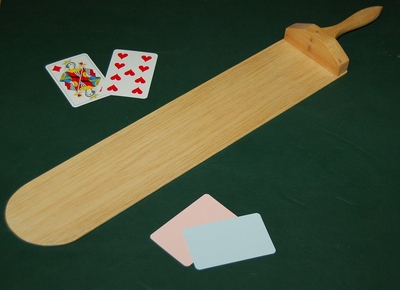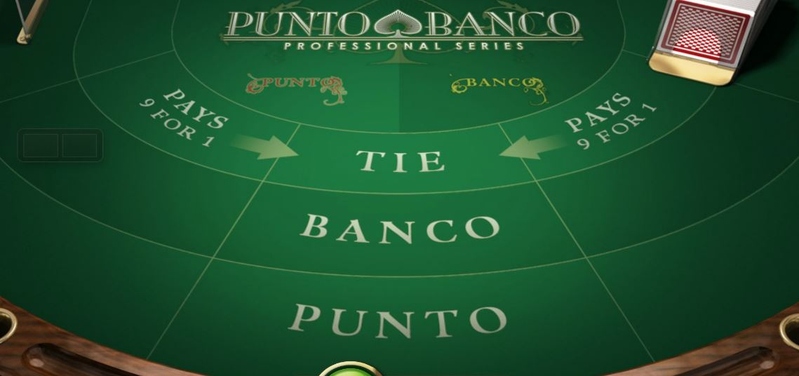Baccarat may be a relatively simple casino game but understanding the differences between all the variations can be a little confusing. If you are planning on giving James Bond’s favourite card game a tryout, it is worth knowing what these differences are before sitting down at a table, whether that is a physical game in a bricks-and-mortar casino or a virtual game at an online casino.
Baccarat
 The most important thing to establish is that baccarat is an umbrella term that covers all variations of the game.
The most important thing to establish is that baccarat is an umbrella term that covers all variations of the game.
Punto banco and chemin de fer are both forms of baccarat so if you play either, it is perfectly correct to say you are playing baccarat.
Think of baccarat as being ‘chocolate’ and within this, you have all the different varieties such as milk, dark, white and so on. This means that when you are playing baccarat, you are always playing one of the variations, even if you might not know which one it is.
The most popular forms of baccarat are punto banco, chemin de fer and baccarat banque and their differences will be explained here.
Before we explain the details of each version, let’s first explain a few things they all have in common:
- Outcomes – Each version has three possible outcomes after a round of play: the player wins, the bank (or banker) wins, or it’s a tie.
- Card Values – Cards two to nine have values that correspond to their number, i.e. a five of diamonds is worth five. Aces are worth one and the 10s, jacks, queens and kings are worth zero.
- Hand Values – To get the value of a hand, you add the values of the individual cards but then take the unit digit only. So, for example, if you have a hand of jack and a five, the hand value would be five. If you have a seven and a nine, the hand value would be six (i.e. the unit digit of 16).
Punto Banco

If you see a game advertised as ‘baccarat’ in countries such as the US, the UK, Australia, Canada or the nations of Scandinavia, it is highly likely that it will be punto banco. This has become very much the standard baccarat variation in these countries (and many more) so there is usually no need to specify punto banco, especially as this may confuse some players. So, if you are unsure which form of baccarat is being played, the safest assumption is to think punto banco.
This form of baccarat involves the player (punto) up against the bank (banco), usually on a kidney-shaped table specifically made for baccarat. ‘Player’ does not refer to people sitting around the table though, as it would do in other games such as blackjack. Instead, it is easier to think of people sitting around a baccarat table as observers. For all intents and purposes, ‘player’ could simply be seen as option A and ‘bank’ as option B. All you need to decide is whether you think the player (option A) or the bank (option B) will win the hand, or if there will be a tie.
As players are not active in the game, simply observing the croupier dish out cards, all moves are forced and there is no decision making involved at all. Successful bets on the player will be paid out at even money while banker bets are paid out at 19/20 (evens with a 5% commission). Despite the commission, betting on the banker is the option with the highest return to player figures (RTP), standing at 98.94%. In punto banco, unlike in other forms of baccarat, betting on a tie is a possibility and this is something that pays out at odds of 8/1.
Chemin de Fer
 The literal translation of this type of baccarat is ‘iron path’ but in reality, French speakers understand it to mean ‘railway’ or ‘railroad’. As it is a touch long as far as names go, and perhaps a little tricky to pronounce for non-French speakers, it is a baccarat variation with some nicknames. You may sometimes see or hear it referred to as chemmy, shimmy or even chernay. Although this is less customary in casinos than punto banco, it is the game James Bond has typically played over the years.
The literal translation of this type of baccarat is ‘iron path’ but in reality, French speakers understand it to mean ‘railway’ or ‘railroad’. As it is a touch long as far as names go, and perhaps a little tricky to pronounce for non-French speakers, it is a baccarat variation with some nicknames. You may sometimes see or hear it referred to as chemmy, shimmy or even chernay. Although this is less customary in casinos than punto banco, it is the game James Bond has typically played over the years.
It has largely similar rules to punto banco but there are differences, one being that players take up a more active role rather than simply only being required to bet without making any decisions. This is made possible because at the start of each round one player will be invited to take on the role of the bank. Should they decline, the banker position will simply be passed on to the closest willing participant.
Any player can accept to be the banker but really it ought to be someone willing to bet a large amount. This is because the amount they wager ideally needs to cover the wagers of all other players around the table. Should another wish to match the banker’s bet in its entirety, they would declare ‘banco’ and this means no other player will be allowed to bet. In the absence of a banco call, players would take it in turn betting until their combined total matched the wager of the banker. Should the total amount fall short, bystanders can be used to make up the shortfall.
Even though several people around the table may have money on the line for the upcoming round, only the player who wagered the most will be handed cards by the croupier. This creates a one versus one, player versus bank situation. The banker will be representing themselves while the player is effectively playing on behalf of everyone else on the table who has bet. The croupier will deal two cards to the banker and two to the player as is standard in any form baccarat, with the aim to score as close to nine as possible.
As the casino takes up a passive role in this form of baccarat, you may be wondering how they make any money. They do this by taking a 5% commission of all winning banker bets, meaning they are not quite paid out at even money. Should the banker win the round they can continue to stay in the role. Lose a round though and the position will be moved onto another player, providing there are any takers.
Baccarat Banque

This form of baccarat is also known as ‘Baccarat à Deux Tableaux’ which as you can probably guess translates to baccarat on two tables. The rules are similar to that of chemin de fer but there is one big difference in that ‘the player’ is dealt two hands rather than one. Rather misleadingly, the game does not take place on two tables, but the table is split into a left and right. One player’s hand is sent to the left side of the table and the other to the right.
As with chemmy, the player who wagered the most on their side of the table will be playing on behalf of everyone else that chipped in. Note that players are not obligated to wager on the near side hand, they can put money on the far side should they wish. The bank plays with just one hand however and whichever player adopts the banker role tends to stay in it for longer, often until they run out of money. The very first banker is usually the person who either signed up first or the one that put up the highest stake.
Differences Overview
No matter which version of baccarat you are playing, they all have the same policy when it comes to which is the winning hand. You would not have a situation where your hand beats another in one version but loses to the exact same hand in another.
Punto banco provides the simplest baccarat version with its key difference being that every player can bet on the banker, tie or player. This is unlike chemin de fer and baccarat banque in which anyone who isn’t the banker always plays with a/the player’s hand.
These latter two variations are more closely related but with baccarat banque, the banker plays against two hands rather than one.
Other Types of Baccarat
 Especially when playing baccarat online, it is easy to come across some other types of baccarat. One popular option is no commission baccarat which removes the 5% commission on banker wins. The house instead collects their small cut by only paying out 50% of the stake should the banker win with a six. Despite this, such games regularly come with a high RTP that exceeds 98%, although it is lower than with standard baccarat (98.94%). There is also EZ baccarat, popular in North America, which also removes the 5% commission but in exchange, any three-card winning banker hands that total seven are paid as a push.
Especially when playing baccarat online, it is easy to come across some other types of baccarat. One popular option is no commission baccarat which removes the 5% commission on banker wins. The house instead collects their small cut by only paying out 50% of the stake should the banker win with a six. Despite this, such games regularly come with a high RTP that exceeds 98%, although it is lower than with standard baccarat (98.94%). There is also EZ baccarat, popular in North America, which also removes the 5% commission but in exchange, any three-card winning banker hands that total seven are paid as a push.
You may also come across mini baccarat, which works in the same fashion as no commission baccarat regarding payouts. It is, however, played on a smaller table with reduced stakes and all actions are performed by the dealer, making it more suited for casual players. Other baccarat variations you might find include speed baccarat, an online game that has a reduced time limit for betting, making it extremely fast paced. Another online alternative is baccarat squeeze. This is just standard punto banco but with one twist being that cards are dealt face down and then slowly squeezed over to reveal the number beneath, adding to the suspense.
Most physical casinos have little desire to stray from the traditional but at online sites, you may find all kinds of differently branded baccarat games. As baccarat is quite a simple card game, none of the variations will be anything radically different but they will have something a little unique, for example optional side bets. This is a feature you will find for example in Fortune 6 baccarat which allows you to bet on whether the bank will win with a hand totalling six. If they do, you will be paid out at 12/1 for a two-card win or 20/1 for a three-card win.
